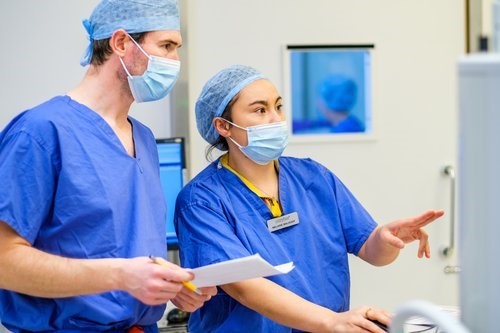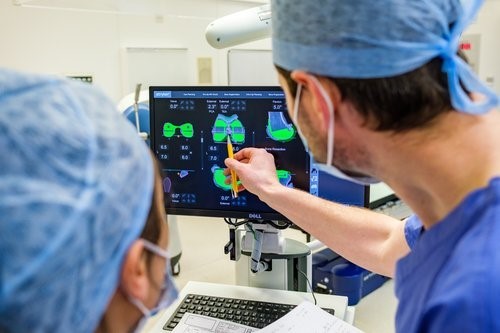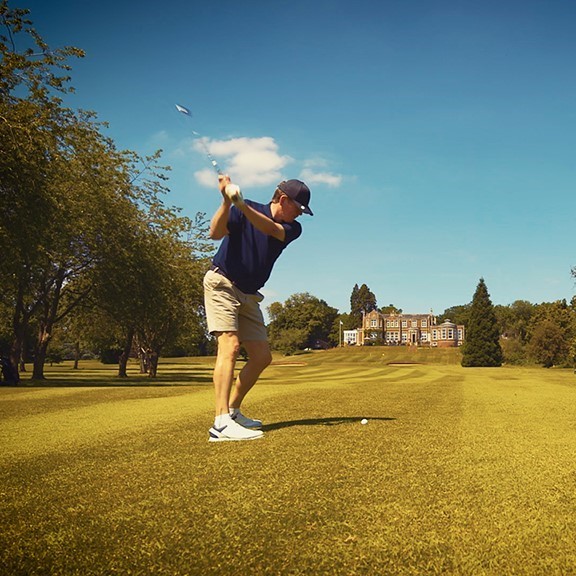Pioneering robot for hip and knee joint replacement
Precision hip and knee surgery with Mako® in Cambridge and surrounding areas.
The Mako robot-assisted procedure
Consultant orthopaedic surgeons at Spire Cambridge Lea Hospital can now use the Mako robotic arm system to assist during total hip replacements, total knee replacements and partial knee replacements. The robotic technology provides a personalised surgical plan for joint replacement surgery.

What is Mako robotic surgery?
The state-of-the-art robotic-arm, Mako, is a precision tool used by our highly qualified team of surgeons helping to improve the accuracy of hip, knee and partial knee replacement surgeries.
Compared to traditional surgery, Mako robot-assisted surgery has been proven to:
- Significantly reduce pain after surgery1
- Allow a faster recovery in early knee movement2
- Perform joint replacement surgery with 2–3 times the accuracy3
What to expect if you choose Mako
CT scans are used to create a 3D model of the patient's knee for pre-surgical planning. In the operating theatre, your surgeon follows the personalised surgical plan while preparing the bone for the joint implant.
The Mako robotic arm guides the consultant within pre-defined areas which prevent them from moving outside planned areas, avoiding the removal of healthy bone tissue.
As the surgeon uses the robotic arm to resurface the knee or hip joint for the placement of implants, the robotic arm uses real-time feedback to guide the surgeon's movements enabling a high degree of precision and accuracy in placing implants.
Getting you back on the move is our priority. Working alongside your Orthopaedic surgeon, our team of physiotherapists will deliver a bespoke care plan to get you back on your feet. You are visited after surgery and a physiotherapist will assess your progress, provide advice and post-operative exercises.
Specialist surgeons using Mako at Spire Cambridge Lea Hospital
Patient case study
Mako hip replacement patient Phillip describes having his surgery allowed him to get back to doing what he loves, playing golf.
View transcript of this video
- [Phillip] I started struggling with my hip about five years ago, to the extent where last year, September, I actually couldn’t play golf at all.
- It gradually got worse to the extent where, when I was playing golf every step was a painful step and I think really what brought it to a head for me was when I was actually struggling to sleep.
- It’s something that I’ve been doing for nearly fifty years now, playing golf and to have that taken away from me suddenly was really, really, very upsetting. So I had to do something to get it fixed.
- My surgery came at a bit of a strange time really because COVID was just starting to set in. It was quite obvious that I wasn't going to get into the NHS system and that was the reason I approached Spire.
- The best thing about my initial consultation was information.
- My surgeon sent me for an MRI and then we had a follow-up consultation and he wrote a four-page report explaining exactly what was wrong with my hip and that was perfect, because prior to that I actually didn't have the information; I didn't know exactly what was wrong with me.
- But once I’d had the MRI and the consultation with my surgeon, we knew exactly what needed doing.
- My surgeon recommended the Mako procedure.
- I was admitted into Spire at seven o'clock in the morning on the Monday and I was actually back home Wednesday lunchtime.
- So I was literally in hospital for two and a half days. I couldn't believe it. I’m very pleased I went through that route.
- [Andrew] The Mako system is really utilising the latest technology for orthopaedic surgery for hips and knees.
- You have a CT planning scan initially which allows you to understand the individual patient anatomy which is unique to every single one of us. That allows a detailed patient-specific preoperative plan that can be then executed in the surgery itself.
- [Graham] Many patients probably have this preconceived idea that the robot is a bit like watching a car being built in a factory and it’s nothing like that, the robot isn't operating independently, the robot is operating with us controlling the robot and that is helping us improve the accuracy of the surgery.
- [Stephen] So I consider Mako to be a bit like having a GPS in the theatre with us. Historically we’ve always used a map to go from A to B and now we all have GPS’ in our cars. It just gives you that additional information of what's going on at every time point throughout the operation.
- [Joel] I’ve witnessed low levels of pain, more rapid rates of recovery in my patients in the post-operative phase, which is fantastic for the early and short term recovery but more beneficial still is the potential for a better outcome in the long term.
- [Chris] I think probably the two things that I’d say that I’ve taken home really is pain-wise following total knee replacements but also I think also confidence.
- So whilst patients have confidence in their surgeons, I think they have additional confidence when there’s a robot involved too.
- [Alastair] Spire Lea has always been looking to think of new ideas, new ways of actually delivering joint replacement surgery in the most effective and successful way possible.
- [Graham] So, Spire Cambridge have always been interested in pushing technology, pushing opportunities and pushing new operative techniques.
- We’re going to be seeing a lot more of robotic surgery in the future and this is an ideal opportunity for us to be using the latest robotic technology to enhance our perioperative care of patients having joint replacement surgery.
- [Phillip] So, when I was unable to walk 18 holes and play golf, I made it my target and I shared this with my surgeon that I would be able to play golf again in the spring and here we are now.
♪ [music] ♪
How Mako works
Based on pre-operative CT scans, the Mako system generates a 3D model of a patient's knee or hip joint. This 3D model is used by the surgeons to determine how much bone to remove, and where to place the implants that replace diseased sections of these bones.

Without Mako, surgeons use a burr saw to remove bone. They work by eye and experience - instead of looking at the bone itself to determine whether enough has been removed. Mako tracks healthy and diseased bone so the surgeon can clearly see how much bone should be removed.
The robotic arm is equipped with a saw and the surgeon is free to remove bone within the boundaries identified during the planning stages. If the surgeon attempts to move outside these boundaries, the saw will turn off. This helps the surgeon minimise the trauma to the hip or knee and preserves the maximum amount of healthy tissue.
Spire Cambridge Lea Hospital,
30 New Road
Impington
Cambridge
CB24 9EL
About Mako
Mako procedures have been carried out for over 10 years, with the first knee replacements being carried out in 2006, and the first hip replacement carried out in 2010. Both procedures were conducted in Florida USA. There are 300+ Mako systems assisting with surgery worldwide spanning 19 countries.
Over 70,000 robotic-arm assisted hip and knee procedures have been carried out so far and over 700 surgeons worldwide regularly perform Mako procedures.
- Accuracy of UKA Implant Positioning and Early Clinical Outcomes in a RCT Comparing Robotic Assisted and Manual Surgery. Blyth MJ; Jones B; MacLean A; Anthony I; Rowe P; 13th Annual CAOS Meeting, June 12-15, 2013, Orlando, FL, USA
- Kayani, Konan, Tahmessabi, Pietrzak, Haddad. Bone Joint J 2018;100-B:930–7. Robotic-arm assisted total knee arthroplasty is associated with improved early functional recovery and reduced time to hospital discharge compared with conventional jig-based total knee arthroplasty
- Bell SW, Anthony I, Jones B, MacLean A, Rowe P, Blyth M. Improved Accuracy of Component Positioning with Robotic-Assisted Unicompartmental Knee Arthroplasty. J Bone Joint Surg Am. 2016 Apr 20;98(8):627-35
Spire Healthcare does not endorse one medical product or device over another. Robotic arm assisted surgery may not be suitable for some patients. Your consultant will help you decide what treatment is best for you.



